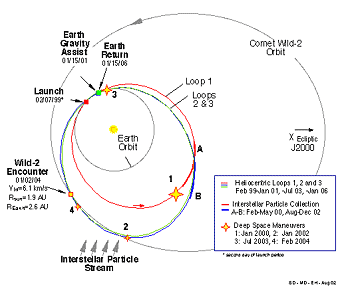The Stardust spacecraft was launched
on February 7, 1999 from the Kennedy Space Center.
 The
first orbital loop was a 2-year VEGA path with a 171
m/s delta-V trajectory correction maneuver (TCM) near
aphelion - the point in the path farthest from the sun.
Delta-V is the amount of change in velocity needed to
alter the spacecraft's course. This delta-V will set
up the Earth swingby to expand the orbit into the 2.5-year
loop. The spacecraft will fly this longer orbital path
twice. The
first orbital loop was a 2-year VEGA path with a 171
m/s delta-V trajectory correction maneuver (TCM) near
aphelion - the point in the path farthest from the sun.
Delta-V is the amount of change in velocity needed to
alter the spacecraft's course. This delta-V will set
up the Earth swingby to expand the orbit into the 2.5-year
loop. The spacecraft will fly this longer orbital path
twice.
At 160 days before encountering Comet Wild 2, a small
delta-V of 66 m/s will set up the Comet Wild 2 flyby.
This will occur on 1 Jan 2004, at 1.86 AU and 97.5 days
past Wild 2 perihelion passage. The spacecraft will
approach the comet at 6.2 km/s from sun side with a
70 degree phase angle. Coma fly-through will be on the
sun side at a planned distance of 300 km from the nucleus.
This flyby occurs five years after launch. The return
of the samples to Earth takes place two years later.
Altogether, three orbits will be made around the sun.
This helps minimize the delta-V requirements for the
mission, further enabling the use of the lighter version
of the Delta II launch vehicle. Additionally, the three
orbits will provide adequate the time for a comprehensive
collection of interstellar dust.
| Last updated January
4, 2004 |
|
